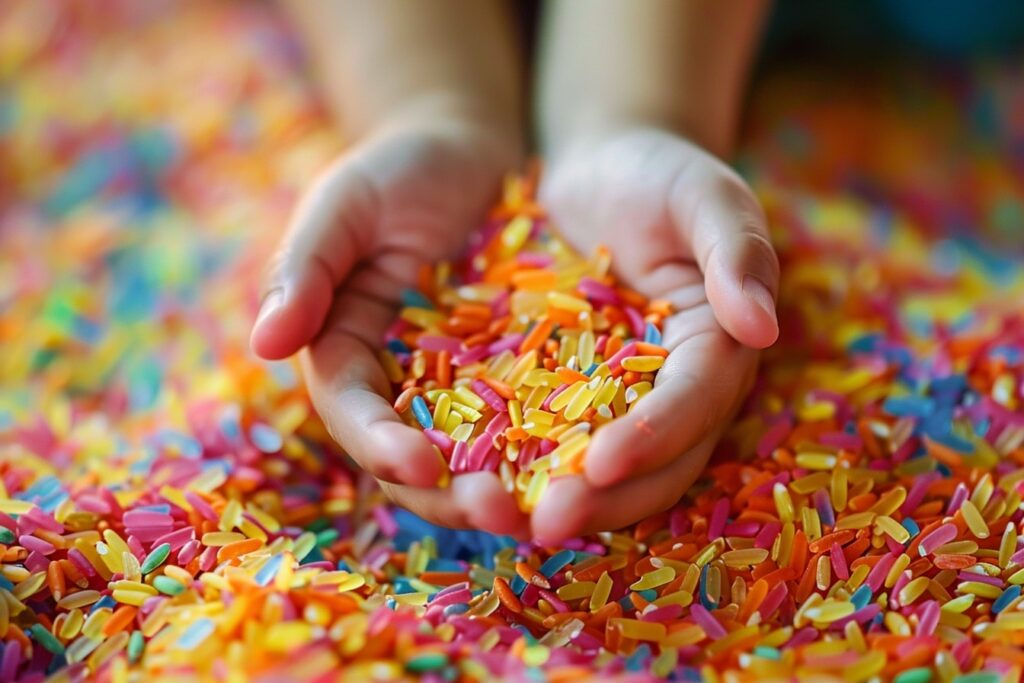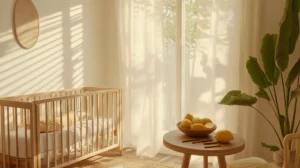Table of Contents
ToggleExploring Texture with a Vibrant Caribbean-Inspired Rice Sensory Bin
Imagine a scene of pure childhood delight: tiny hands eagerly reaching into a rainbow of colors, each grain of rice a miniature treasure waiting to be discovered. This is the magic of sensory play, where children’s imaginations come alive amidst a symphony of textures and hues. And what better way to ignite their senses than with a Caribbean-inspired rice sensory bin?
As a parent, I’ve witnessed firsthand the joy and wonder that sensory play brings to my child’s development. Whether it’s squishing playdough between their fingers or splashing in a tub of water, these simple yet meaningful experiences lay the foundation for learning and exploration.
But why stop there? With a dash of Caribbean flair, we can elevate sensory play to new heights, infusing it with the vibrant colors and rich textures of Caribbean culture. From the golden sands of the beaches to the lush greenery of the rainforests, the Caribbean is a treasure trove of sensory experiences waiting to be discovered.
In this article, we embark on a journey to create a sensory experience that not only delights the senses but also celebrates the beauty and diversity of Caribbean culture. Join me as we dive into the world of sensory exploration and discover the magic that awaits within our colorful rice sensory bin.
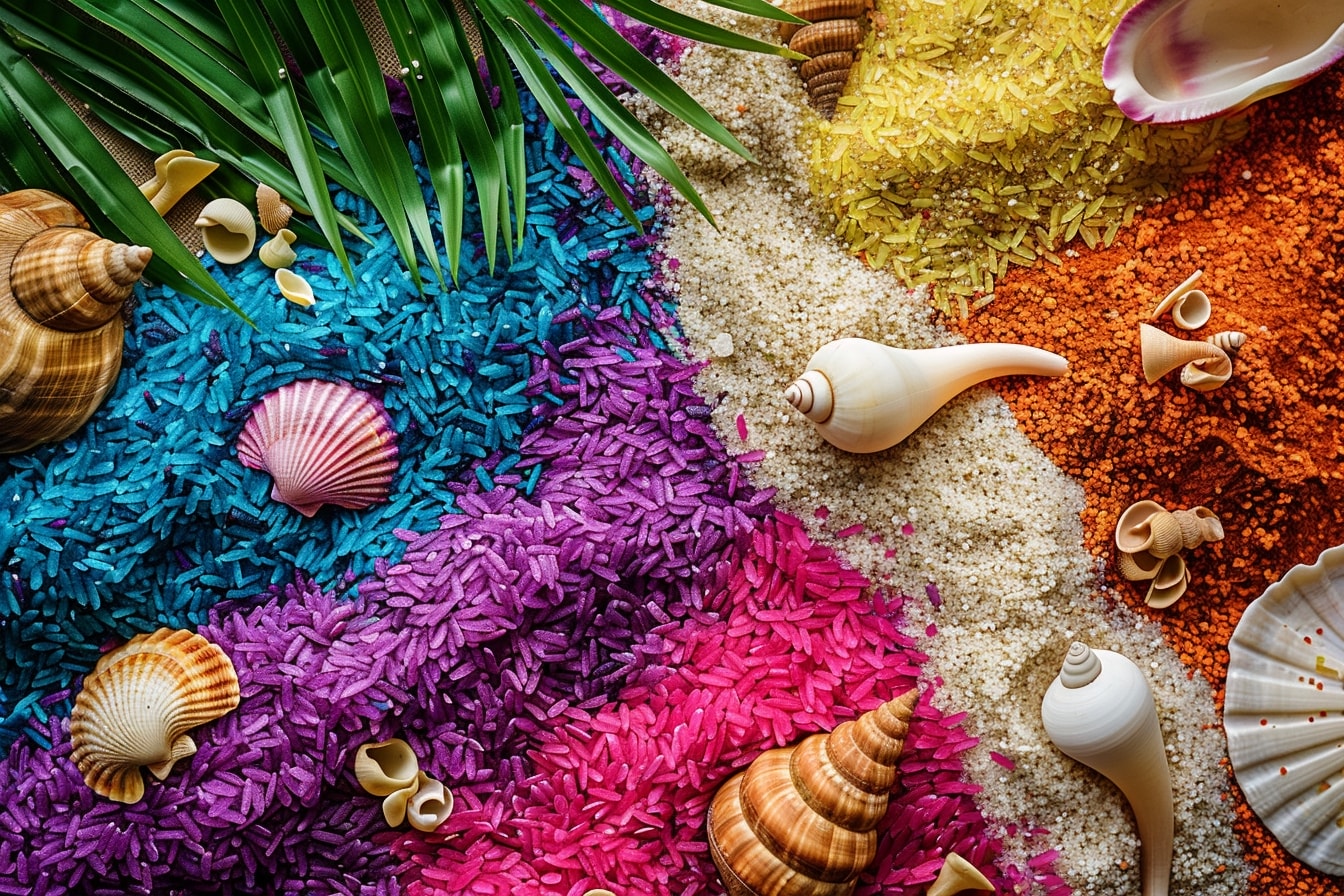
Infusing Caribbean Flavors: Creating a Colorful Rice Sensory Bin
Welcome to the heart of our sensory adventure, where we bring the vibrant colors and tantalizing flavors of the Caribbean straight to your child’s fingertips. Creating a colorful rice sensory bin inspired by Caribbean culture is not just about providing a feast for the senses—it’s about immersing your child in a world of sensory exploration and cultural discovery.
First things first, let’s gather our materials. To bring our sensory bin to life, you’ll need a few key ingredients:
- White rice: This will serve as the base for our sensory bin, providing a neutral canvas for our colorful creations.
- Food coloring or natural dyes: Get ready to unleash your inner artist with an array of vibrant hues. From deep blues reminiscent of the Caribbean sea to sunny yellows inspired by tropical fruits, the possibilities are endless.
- Caribbean-inspired accessories: To add an extra touch of authenticity to our sensory bin, consider incorporating elements such as seashells, mini palm trees, or even small toy boats. These playful additions will transport your child to a Caribbean paradise with each scoop and pour.
Now that we’ve gathered our supplies, it’s time to get creative. Let’s dive into the process of dyeing our rice and bringing our sensory bin to life:
- Start by dividing your white rice into separate bowls, one for each color you wish to create. Remember, the more colors, the merrier!
- Next, add a few drops of food coloring or natural dye to each bowl, adjusting the amount to achieve your desired shade. For a truly Caribbean twist, consider using natural ingredients such as turmeric for a sunny yellow or beetroot powder for a vibrant pink.
- Using a spoon or your hands, mix the dye thoroughly into the rice until the color is evenly distributed. Don’t be afraid to get messy—this is all part of the fun!
- Once you’ve dyed all of your rice colors, spread them out on a baking sheet or parchment paper to dry. This will help prevent the colors from bleeding and ensure that your sensory bin stays vibrant and inviting.
With our rice dyed and our accessories at the ready, it’s time to assemble our sensory masterpiece. Here are a few tips for setting up your colorful rice sensory bin:
- Choose a large, shallow container to serve as the base of your sensory bin. This will give your child plenty of room to explore and play.
- Layer your colored rice in the bottom of the container, creating a rainbow of textures and hues. Encourage your child to mix and swirl the rice together, creating new colors and patterns with each movement.
- Add your Caribbean-inspired accessories to the mix, scattering them throughout the rice for an extra touch of magic. Watch as your child’s imagination takes flight, transforming the sensory bin into a tropical paradise.
And there you have it—the recipe for a sensory experience that’s as colorful and vibrant as the Caribbean itself. So grab your rice and your imagination, and let’s embark on a sensory adventure that’s sure to delight and inspire!
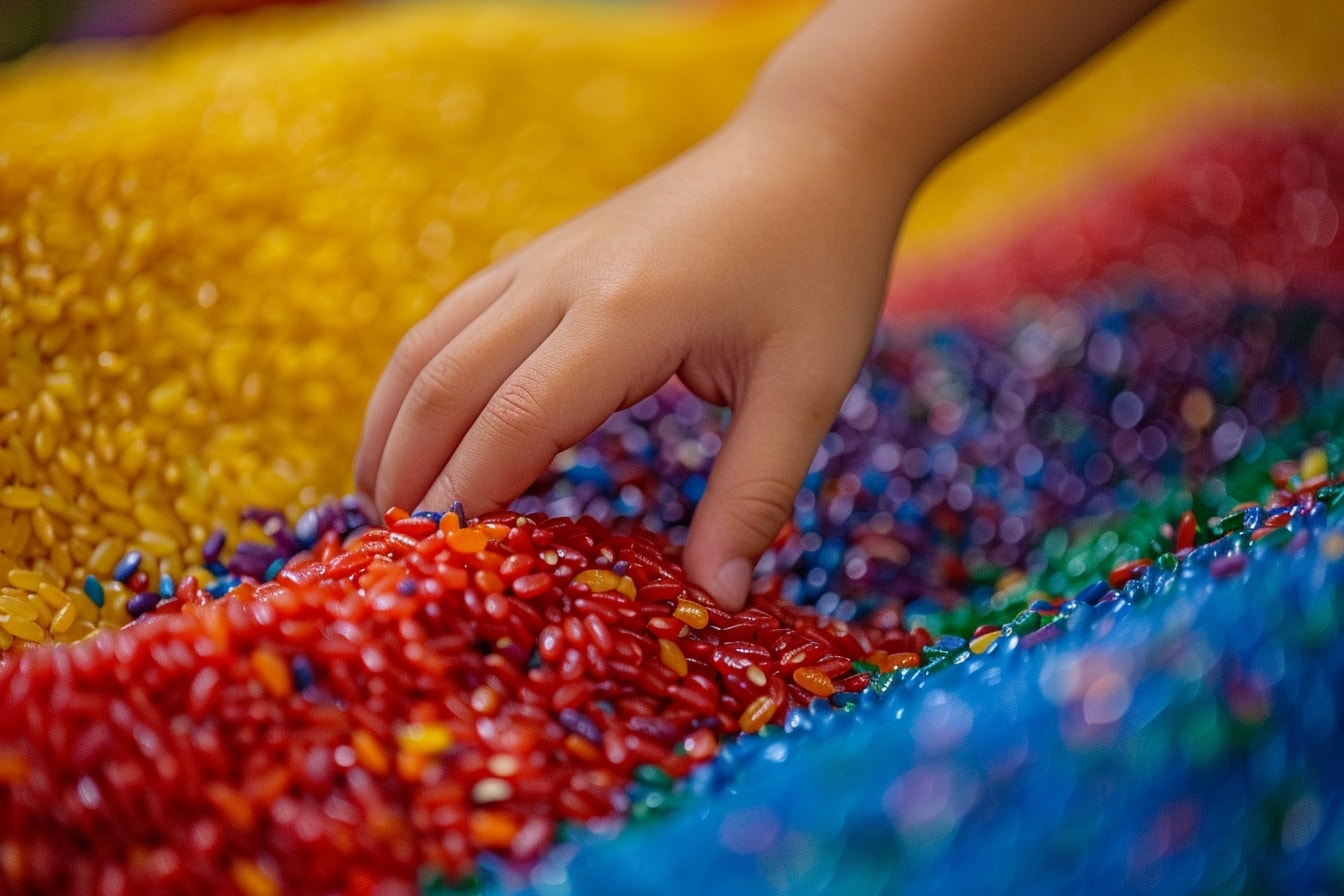
Embracing Texture: Sensory Benefits for Children
Let’s dive into the heart of sensory play—the exploration of texture. For children, texture is more than just a tactile sensation—it’s a gateway to understanding the world around them. As they squish, squeeze, and mold different materials, they’re not just engaging their senses—they’re building crucial cognitive and motor skills that will serve them for a lifetime.
But what exactly are the benefits of embracing texture through sensory play? Let’s explore:
- Sensory Processing: By exposing children to a variety of textures, sensory play helps them develop their sensory processing skills—the ability to interpret and respond to sensory stimuli. Whether it’s the roughness of sand between their fingers or the smoothness of a polished stone, each texture offers a new opportunity for learning and growth.
- Fine Motor Skills: Manipulating different textures requires precision and control, making sensory play a valuable tool for developing fine motor skills. As children pick up, pinch, and grasp objects within the sensory bin, they’re honing their hand-eye coordination and dexterity in a fun and engaging way.
- Sensory Integration: Sensory play encourages children to engage multiple senses simultaneously, helping them integrate sensory information and make sense of their surroundings. As they explore the textures of the rice sensory bin, they’re not just feeling with their hands—they’re also observing, listening, and even tasting, creating rich sensory experiences that stimulate their growing minds.
But the benefits of texture exploration extend beyond cognitive and motor development—they also have profound implications for children’s emotional and social well-being. Here’s how:
- Calming and Soothing: For many children, sensory play offers a calming refuge in a world filled with noise and stimulation. The repetitive motions of scooping and pouring rice can be incredibly soothing, providing a sense of comfort and security during times of stress or anxiety.
- Self-Expression: Texture exploration is a form of self-expression, allowing children to communicate and connect with the world around them in a meaningful way. Whether they’re creating intricate patterns in the rice or molding it into imaginative shapes, sensory play gives children the freedom to express themselves creatively and authentically.
- Social Connection: Sensory play is often a communal experience, providing opportunities for children to engage with their peers in meaningful ways. As they collaborate and cooperate within the sensory bin, they’re not just sharing toys—they’re sharing experiences, building friendships, and learning important social skills such as sharing, taking turns, and resolving conflicts.
So, the next time you’re tempted to dismiss sensory play as just another messy activity, remember the profound impact it has on children’s development and well-being. By embracing texture and providing opportunities for sensory exploration, we’re not just filling our children’s playtime with fun—we’re laying the foundation for a lifetime of learning, growth, and connection.
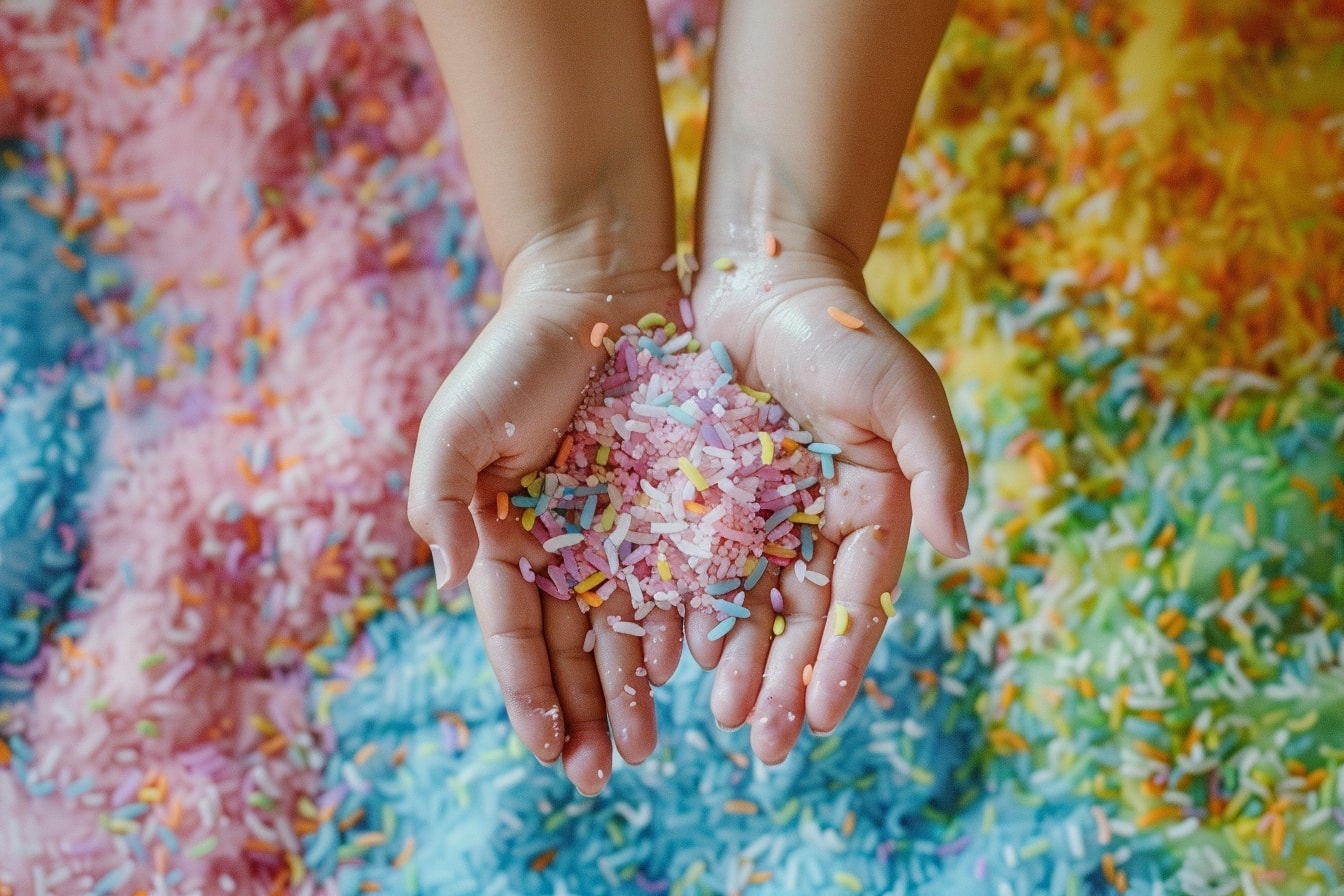
Navigating Mess and Cleanup: Practical Tips for Parents
Now, let’s address the elephant in the room: the inevitable mess that comes with sensory play. As much as we adore watching our little ones explore and create, the thought of cleaning up after can be daunting. But fear not, fellow parents! With a few simple strategies, navigating the mess and cleanup process can be a breeze.
Here are some practical tips to help you tackle the mess head-on:
- Containment is Key: Before diving into sensory play, set boundaries to contain the mess. Use a large plastic bin or tray with high sides to keep the rice contained and prevent spills onto the floor. This creates a designated play area where your child can explore freely without leaving a trail of rice in their wake.
- Lay Down Protection: For added peace of mind, lay down a tarp or old sheet underneath the sensory bin to catch any stray grains that may escape. This makes cleanup a breeze—simply gather up the corners of the tarp and shake off any excess rice before folding it away for next time.
- Embrace Easy Cleanup Methods: When it comes time to tidy up, opt for quick and efficient cleanup methods that won’t leave you feeling overwhelmed. Keep a handheld vacuum or dustpan and brush nearby for easy removal of rice grains from tabletops and floors. Alternatively, consider using a lint roller or adhesive tape to pick up stray grains from hard-to-reach places.
- Involve Your Child: Turn cleanup into a fun and interactive activity by involving your child in the process. Encourage them to help sweep up rice grains or use a handheld vacuum to suck up any stray crumbs. Not only does this teach them responsibility and good hygiene habits, but it also fosters a sense of pride and accomplishment in contributing to the household chores.
- Establish a Routine: Make cleanup a regular part of your sensory play routine to prevent messes from piling up. Set aside a few minutes at the end of each play session to tidy up together as a family. By making cleanup a shared responsibility, you’ll instill good habits that will benefit your child for years to come.
Remember, messes are simply a byproduct of the joy and learning that comes with sensory play. By implementing these practical tips and embracing the inevitable messiness, you can create a stress-free environment where your child can explore, create, and learn without limits.
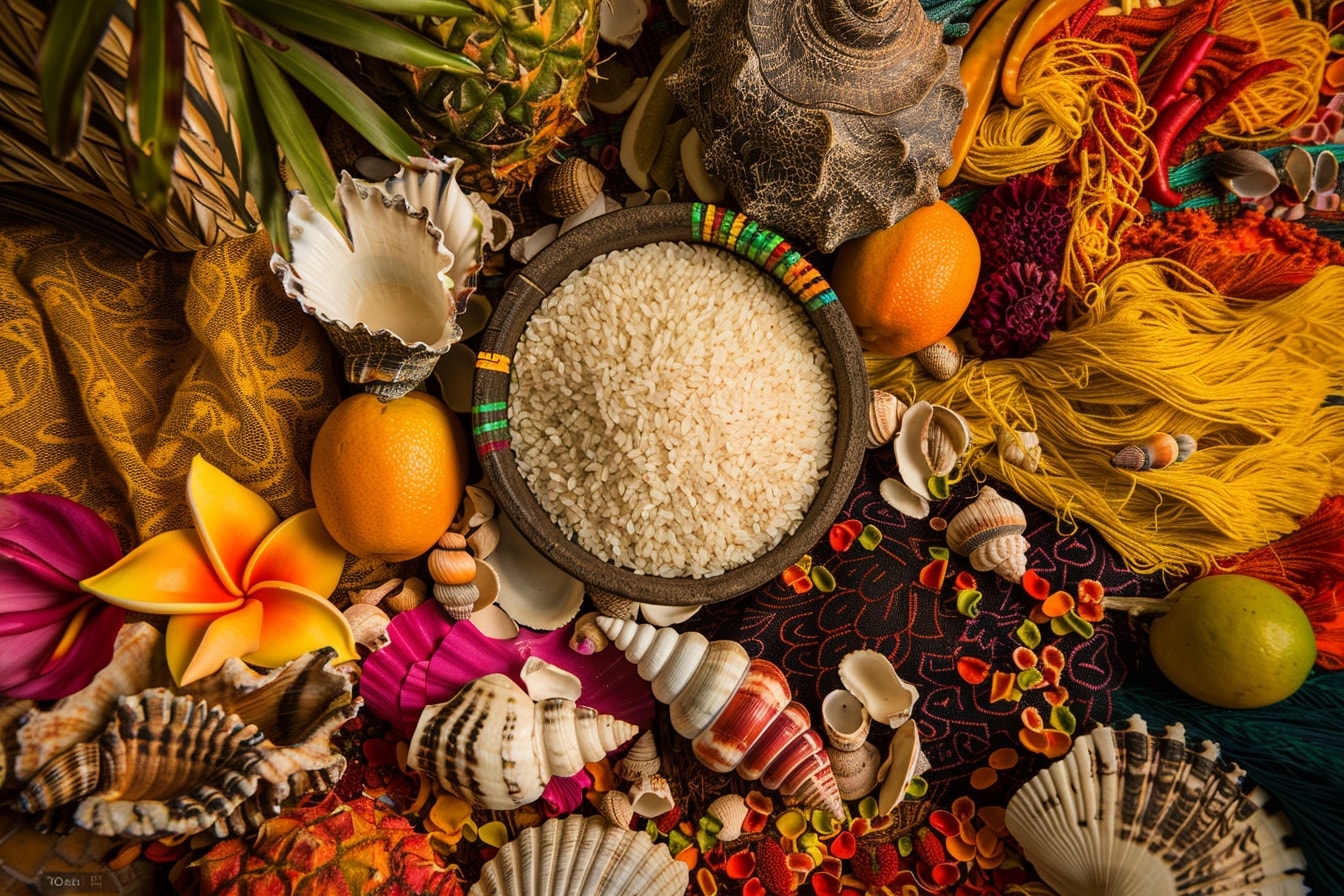
Cultural Connection: Exploring Caribbean Traditions
Prepare to embark on a journey through the rich tapestry of Caribbean culture, where every tradition and custom is a vibrant celebration of life. As we dive into the sensory experience of our rice bin, we also immerse ourselves in the sights, sounds, and flavors of the Caribbean, connecting with a culture steeped in history and diversity.
At the heart of Caribbean traditions lies a deep reverence for the land and sea, reflected in the region’s culinary customs and agricultural practices. Rice, known as the grain of life, holds a special place in Caribbean cuisine, serving as a staple ingredient in dishes ranging from savory rice and peas to indulgent coconut rice pudding.
But rice is more than just a source of sustenance—it’s a symbol of community and hospitality, woven into the fabric of Caribbean life. From festive gatherings to everyday meals, rice plays a central role in bringing people together, fostering bonds of friendship and kinship that transcend generations.
As we explore the sensory delights of our rice bin, we also pay homage to the cultural significance of rice in Caribbean traditions. From the rhythmic beat of steel drums to the tantalizing aroma of jerk chicken sizzling on the grill, each sensory experience evokes memories of Caribbean celebrations and gatherings.
But our cultural exploration doesn’t stop there. As we delve deeper into Caribbean traditions, we uncover a rich tapestry of customs and rituals passed down through the ages. From the colorful costumes of Carnival to the rhythmic movements of traditional dance, each tradition tells a story of resilience, creativity, and unity.
Through sensory play, we have the opportunity to not only engage our senses but also connect with the cultural heritage of the Caribbean. By incorporating elements of Caribbean culture into our sensory experience, we honor the traditions of the past while celebrating the diversity of the present.
So as we sift through the grains of rice in our sensory bin, let us also open our hearts and minds to the beauty and vibrancy of Caribbean culture. Together, we embark on a journey of exploration and discovery, where every sensory experience is a celebration of life, love, and connection.
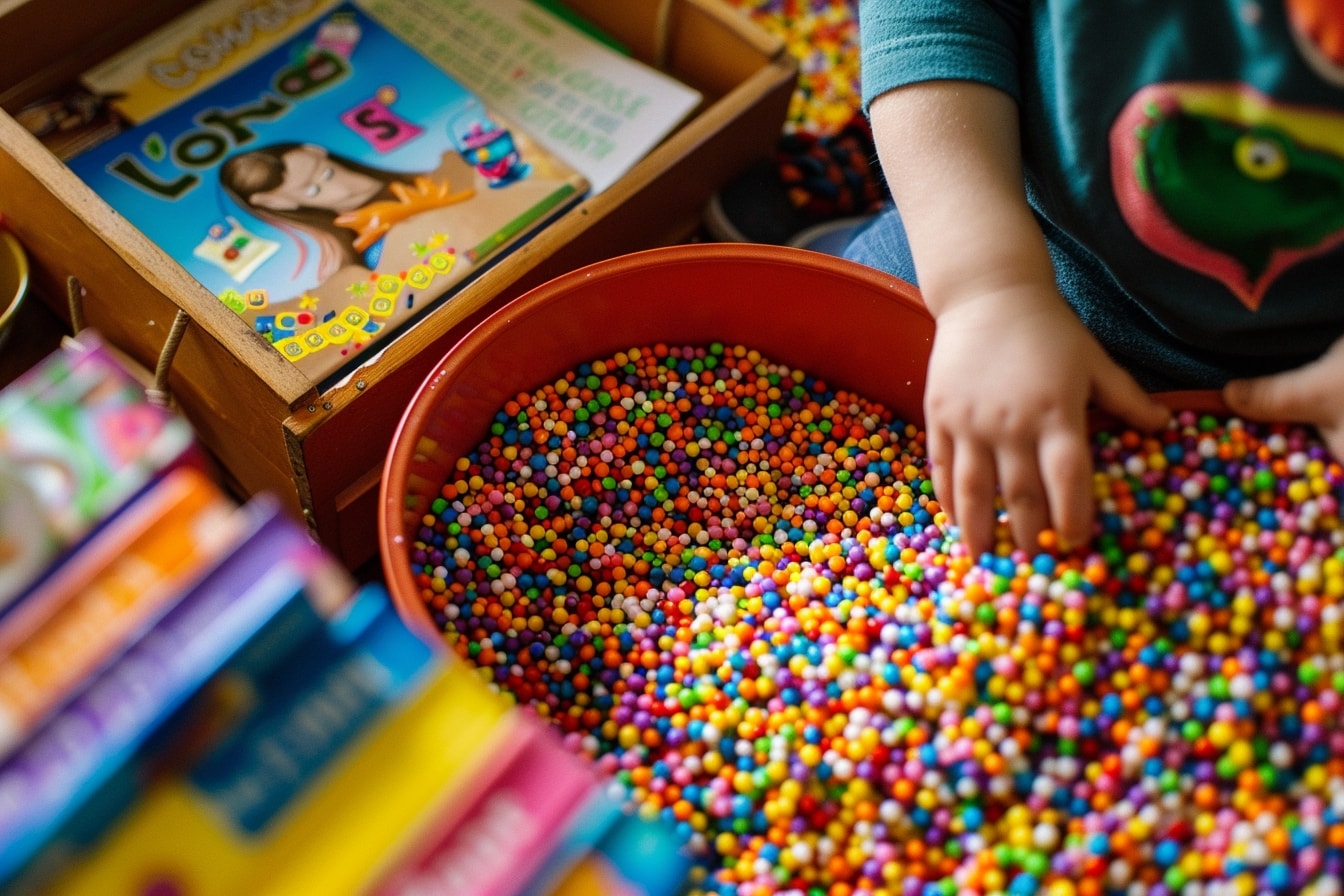
Beyond the Bin: Extending the Learning Experience
As we bid farewell to our colorful rice sensory bin, our journey of exploration is far from over. In fact, the sensory experience we’ve created serves as just the beginning of a rich and multifaceted learning adventure that extends far beyond the confines of the bin. So, let’s embark on the next phase of our journey and explore how we can extend the learning experience for our little ones.
Here are some creative ways to take the sensory exploration to new heights:
- Themed Art Projects: Harness the creative energy sparked by sensory play and channel it into themed art projects inspired by Caribbean culture. From painting with rice to creating textured collages using rice grains and other natural materials, the possibilities are endless. Encourage your child to experiment with colors, shapes, and textures as they bring their artistic visions to life.
- Culinary Adventures: Take a culinary journey through the flavors of the Caribbean by cooking up a feast of traditional dishes together as a family. Invite your child to help measure ingredients, stir pots, and taste-test exotic flavors as you whip up classic Caribbean recipes like Jamaican jerk chicken, Trinidadian roti, or Cuban black beans and rice. Not only does this provide a hands-on learning experience, but it also fosters an appreciation for diverse cuisines and cultures.
- Literacy and Numeracy Activities: Infuse learning into everyday activities by incorporating literacy and numeracy skills into your sensory play. Hide alphabet letters or numbers in the rice for your child to discover and identify, or challenge them to sort rice grains by color or size. You can also use the rice bin as a backdrop for storytelling, encouraging your child to narrate their own tales inspired by Caribbean culture.
- Nature Walks and Outdoor Explorations: Take the sensory experience outdoors and explore the natural beauty of the world around you. Go on nature walks to discover the sights, sounds, and textures of the Caribbean landscape, from sandy beaches to lush rainforests. Collect natural treasures like seashells, leaves, and stones to incorporate into future sensory play activities, fostering a deeper connection to the world around them.
- Community Engagement: Get involved in your local community and seek out opportunities to connect with Caribbean culture firsthand. Attend cultural festivals, food fairs, or art exhibitions showcasing Caribbean traditions and customs. Engage with members of the Caribbean community and learn from their firsthand experiences, gaining insight into the rich tapestry of Caribbean culture and heritage.
By extending the learning experience beyond the sensory bin, we open up a world of possibilities for our children to explore, discover, and grow. So let’s embrace the journey ahead and continue to nurture their curiosity, creativity, and connection to the vibrant culture of the Caribbean.
As we reach the end of our sensory adventure, it’s time to reflect on the vibrant tapestry of experiences we’ve woven together. From the colorful rice sensory bin to the rich cultural explorations that followed, our journey has been nothing short of magical.
Throughout this article, we’ve delved into the world of sensory play with a Caribbean twist, immersing ourselves in the sights, sounds, and flavors of this diverse and vibrant region. We’ve seen how sensory play not only engages the senses but also fosters learning, creativity, and connection.
But perhaps most importantly, we’ve witnessed the joy and wonder that comes from embracing sensory exploration with our children. In every squish of rice between tiny fingers and every gleeful giggle as they discover something new, we see the spark of curiosity and imagination that fuels their growth and development.
As parents, educators, and caregivers, it’s our privilege and responsibility to nurture that spark—to create environments where our children can learn, explore, and thrive. Whether it’s through sensory play, cultural exploration, or everyday adventures, we have the power to shape their world and inspire a lifelong love of learning.
So as we bid farewell to our rice sensory bin and the memories we’ve created together, let’s carry the spirit of curiosity and discovery with us wherever we go. Let’s continue to seek out new experiences, celebrate diversity, and embrace the joy of learning alongside our children.
Thank you for joining me on this journey. May your days be filled with laughter, love, and endless opportunities for sensory exploration and cultural connection.
Want to take your knowledge to the next level? Check out these must-read articles:
- Tape Resist Art: Abstract Creations with Tape and Paint
- DIY Toddler-Friendly Bowling: Rolling Fun at Home
Organize your baby’s wardrobe with our baby clothes closet organizer products! Our organizers are designed specifically for baby clothes. Get your baby’s clothes neat and tidy with our selection of organizers – shop now!
Step into Sue Brown's World of Baby Care, where you'll find a treasure trove of knowledge and wisdom waiting to be explored. Sue's dedication to providing accurate and up-to-date information on baby care shines through in every article, blog post, and resource she shares. From newborn essentials to sleep training tips, breastfeeding advice to nurturing your baby's development, Sue covers a wide range of topics that are essential for every parent to know. Her warm and compassionate approach creates a sense of community and reassurance, making her website a safe haven for parents seeking guidance and support. Let Sue Brown be your partner in this beautiful journey of parenthood, as she empowers you to create a loving, nurturing, and thriving environment for your little one.
- Indoor Air Quality for Infant Respiratory Health - October 20, 2025
- Positive Discipline Foundations: Setting the Stage From Infancy - October 18, 2025
- 2025’s Most Innovative Baby Products Worth the Investment - October 16, 2025

